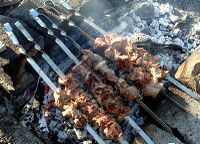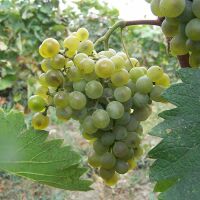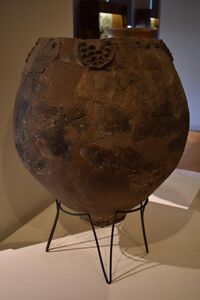Salikhia
This article is incomplete because it is pending further input from participants, or it is a work-in-progress by one author. Please comment on this article's talk page to share your input, comments and questions. Note: To contribute to this article, you may need to seek help from the author(s) of this page. |
Sotirian Republic of Salikhia წაწოლიველო (Salikh) Tsatsolivelo | |
|---|---|
|
Flag | |
Motto: „ამ მომენტს საუკუნეებია ველოდებით!” (tr.) "Am moment’s sauk’uneebia velodebit!" "We have been waiting this moment for ages!" | |
 Salikhia in dark green, within Samorspi, light green. | |
| Capital and largest city | Archangel |
| Official languages | Salikh |
| Ethnic groups (2014) | |
| Demonym(s) | Salikh |
| Government | Unitary teocratic presidential republic |
| Atanas III | |
• Premier | Miku Datunashvili |
| Legislature | Salikh Duma |
| Area | |
• Total | 96,965[1] km2 (37,438 sq mi) |
• Water (%) | 3.5% |
| Population | |
• 2023 estimate | 9,964,740 |
• 2014 census | 9,381,203 [2] |
• Density | 102.76/km2 (266.1/sq mi) |
| GDP (PPP) | 2023 estimate |
• Total | |
• Per capita | |
| GDP (nominal) | 2023 estimate |
• Total | |
• Per capita | |
| Gini (2022) | 37.1 medium |
| HDI (2022) | 0.837 very high |
| Currency | Salikh Lari (₾) (SKL) |
| (DST) | |
| Date format | dd.mm.yyyy |
| Driving side | right |
| Internet TLD | .sk |
The Sotirian Republic of Salikhia (Salikh: წაწოლიველო, tr: Tsatsolivelo), also known simply as Salikhia, is a sovereign state in western Euclea. This nation shares borders with Soravia to the north, Laudania and Bistravia to the east, and the Lake Min to the south. Archangel (Salikh: მთავარანგელოზი, tr: Mtavarangelozi) is the capital of the country, and its largest city. Salikhia has a population of 9.9 million and an area of 96,965 km2 (37,438 sq mi) under its administration.
The nation's history dates back to the ancient Tskhannic Empire, the later Kingdom of Salikhia, and latterly Tskhannia and Samkhresalikhia. Salikhia reached its peak during the so-called Classical Era between the 10th and 13th centuries. In the mid-19th century, Salikhia was annexed by the Soravian Empire. From 1922 to 1979 the Federal Sovereign Republic of Salikhia was one of the thirteen federal republics of the All-Soravian Union of Republics. On 9 April 1979, shortly before the collapse of the ASUR, Salikhia declared its independence.
Like many post-Soravian countries, Salikhia endured a difficult time during the first half of the 1980s, but through the Christmas Revolution of 1984, Miku Datunashvili assumed the nation's leadership, introducing countless economic, political and diplomatic reforms, which he called part of his Revivalist State, inspired by some of the policies of the defunct ZVNP. Today, Salikhia is one of the fastest growing nations in Euclea, but also one of the most conservative.
Etymology
Salikhia was the name given to the region that currently occupies the homonymous nation, based on a nickname that the inhabitants of the area had for their lands, Tsolikia: This is surely due to the white grape Tsolikouri, endemic to the Salikh northern mounts, and the favorite of foreign explorers and merchants who wandered through the region. The Tsolikouri is the most symbolic of all the vines characteristic of the impressive viticulture of the nation, which is known as the cradle of wine, thanks to its more than 8000 years of tradition. The native name of Salikhia, წაწოლიველო (Tsatsolivelo), then could literally be translated as Land of Wine; the self-denomination for the native language is წაქული (Tsakuli).
History
Salikhia's first stories
The Salikh history begins at the same time as the history of wine; an old legend tells that the Salikh people flourished alongside the vines, being born in the first harvest. Objectively speaking, this legend is probably not far wrong. While we can talk about proto-Salikh populations as far back as the 11th century BC, wine began to form part of the national culture as early as the 9th century BC; the cultivating populations began to form small settlements (mostly in the fertile south), while some other groups remained nomadic (mainly in the more hostile and rugged north). These differences began to divide the proto-Salikh into two groups by the 3rd century BC; the Tsoliki (modern-day Salikh) and the Galoperi (a name derived from the fact that they became famous for being, according to the Tsoliki, "barbarians on horseback"). The Galoperi, having succeeded in domesticating Przewalski's horse around 3500 BC, began to organize into hordes (of up to 80 men), and to expand into western Euclea, mainly to the western coast. Meanwhile, the southern regions beginning to organize into Dzkalabis (city states, probably from the expression dzveli kalakebi, meaning old cities). Slowly, the Galoperi were fighting and learning from other nomadic cultures, such as the Savaders. An empire was beginning to form, the Tskhannic Empire (named after the word tskheni; horse).
Tskhannic Empire & Principality of Archangel
Kingdom of Salikhia
losSoravian Conquest
Great Collapse & Great War
Soravian Republic
Provisional Republic
Revivalist State
Current situation
Geography
Administrative divisions
Government and Politics
Government
Administrative divisions
Law and justice
Law enforcement
Foreign relations
Military
- Main article: Salikh Armed Forces
Economy
Agriculture
Transport
Energy and infrastructure
Science and technology
Tourism
Demographics
Major cities
Largest cities or towns in Salikhia
National Institute of Statistics and Census (2014) | |||||||||
|---|---|---|---|---|---|---|---|---|---|
| Rank | Olki | Pop. | |||||||
 Archangel  Aghmosavleti |
1 | Archangel | Samkhresalikhia | 4,117,311 |  Svekvishumi  Kalazumi | ||||
| 2 | Aghmosavleti | Gulia | 567,602 | ||||||
| 3 | Svekvishumi | Samkhresalikhia | 401,283 | ||||||
| 4 | Kalazumi | Sanakhita | 173,301 | ||||||
| 5 | Arauli | Araulebia | 165,995 | ||||||
| 6 | Okroski | Okrosia | 161,732 | ||||||
| 7 | Dziaderumi | Samkhresalikhia | 130,516 | ||||||
| 8 | Maudebi | Vazebia | 106,659 | ||||||
| 9 | Qalqerzi | Tskhannia | 93,409 | ||||||
| 10 | Zorovi | Zorovikhia | 89,577 | ||||||
Ethnic groups
Salikh identity
Language
Religion
Health
Education
Culture
Heritage Sites
Architecture
Visual Art
Performing arts
Philosophy
Sport
Cuisine
Salikh cuisine can vary greatly depending on the region we are talking about; typically and making some generalisations, the northern regions, heirs to the cuisine of old Tskhannia, tend to prefer more rustic and simple dishes, based on grilled meats; the southern regions, historically more developed, tend to prefer more delicate and complex preparations, such as Khinkali, or Khachapuri. The most common ingredients tend to revolve around wine, dairy products, walnuts, peanuts, and olives.

During winter and Easter, the consumption of Sturgeon is very popular, the most popular way to do it is to marinate specially cut pieces with a sauce based on tomato paste and yogurt, seasoned with ginger and other spices, and then skewer the fish on a sword or skewer, making what is locally called shemtsvarikhmali, and then cook the result over a fire or grill. The shemtsvarikhmali, not only of Sturgeon, but also using any type of meat, is the national dish of the country, being popularly consumed in social and family gatherings, thanks to its easy and fast way of elaboration. This dish has its origins in the Tskhannic Empire, being a popular meal among the soldiers of the hordes, as it only required a clean sword, fire, and any meat or fish that was available.
Salikh cuisine and wine have evolved through the centuries, adapting traditions in each era. One of the most unusual traditions of dining is supra, or Salikh table, which is also a way of socializing with friends and family. The head of supra is known as tamada. He also conducts the highly philosophical toasts, and makes sure that everyone is enjoying themselves. A successful tamada must be able to hold long and interesting talks, and be able to drink heavily without showing almost any signs of drunkenness. Rather than serving food in courses, traditional supras often present all that a host has to offer.
Salikhia's moderate climate and moist air, influenced by the Lake Min, provide the best conditions for vine cultivation. The soil in vineyards is so intensively cultivated that the grapevines grow up the trunks of fruit trees eventually hanging down along the fruit when they ripen. This method of cultivation is called maglari. Wine, and its associated traditions, is an indispensable part of the national identity and is probably the most recognized aspect of the country worldwide.





